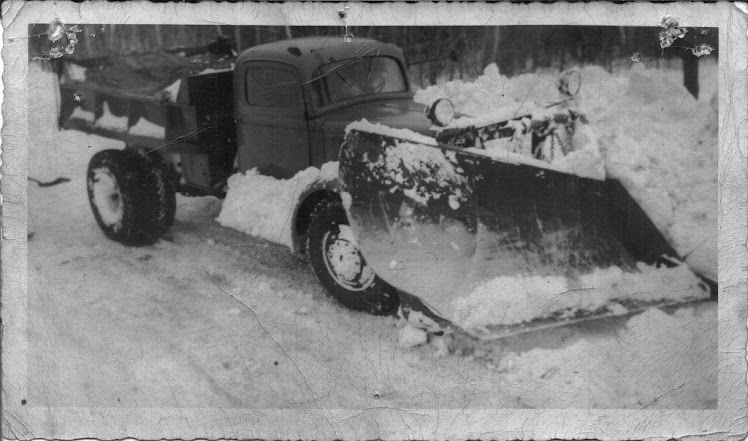Towplow: Below are my responses to an engineering student from Western Michigan University who was looking for Towplow information as he was doing a term paper on the economics of using A Towplow on I-94 and US-131 in the Kalamazoo, Michigan area. I doubt my response was what he anticipated.
Michigan Department of Transportation has already proven the most economical and efficient method(s) for snow & ice control: lower speeds for salt applications, prewet material,use anti-icing when possible, higher payload trucks equipped with mid-mount wing plows and underbody scrapers, ground speed oriented salting systems, concentrate salt application on centerline (band application compared to broadcasting), allow salt enough time to "work", and continuous operator training.
1.) Except for a
very short section of I-94, both US-131 and I-94 are four lane interstate (two
lanes per side). If you plow with a
TowPlow, you will block both lanes. What
speed do you suppose they plow using the TowPlow? 35 m.p.h?
So all traffic behind the TowPlow is held to 35 miles per hour during
the entire plow route? What about
"user delay costs" (and there have been studies that do provide a
cost for user delay)?
Someone (or ones) will attempt to pass the TowPlow on the
shoulder of the road creating a hazardous situation.
2.) Does TowPlow
have a trip mechanism in case it hits something (manhole cover, raised
joint)? So what gets damaged?
3.) If TowPlow
hydraulic system fails or truck hydraulic system fails or truck engine stalls,
the road is blocked until help arrives.
4.) TowPlow is
constructed of mild steel. It is
equipped with hydraulic cylinders with chrome rods. Mild steel is prone to corrosion when used
around chlorides. You can purchase a
TowPlow with a liquid application system or granular, both of which spread
chlorides. Life expectancy will depend
largely on after storm clean-up. Point
to ponder, ever wonder why most agencies purchase stainless steel salt hoppers
and in some cases, dump bodies?
5.) Indiana DOT
has a TowPlow evaluation underway in the Fort Wayne area on the bypass. I traveled down there and visited with their
forces and scrutinized their TowPLow. It
is equipped with a salt hopper. The
hopper on the TowPlow distributes material off a spinner (broadcast). The frame of the TowPLow was covered in
salt. That means the plow frame is being
attacked by salt that never made it to the trunkline, neither scenario a good
situation.
6.) The truck
towing the TowPlow had a hopper and was distributing salt directly on tongue of
TowPlow. Once again, the TowPlow was
being attacked by salt that never made it to the trunkline. Plus the salt that did hit the road surface
was "bounced and scattered" by hitting tongue first.
How much does salt usage increase because of the inefficient method of
distribution? Anyone tracking that?
7.) Michigan DOT
applies salt in a band (windrow) application on the centerline or high spot of
road (outside shoulder on banked ramps).
Their equipment is designed for that type of application. Their MAXIMUM salt application rate,
controlled by a microprocessor in each truck) is 450# per lane mile. Their salt application equipment is not
compatible on a TowPlow or the towing truck.
And, in Indiana DOT they were only controlling output of one hopper with
their microprocessor, the other hopper was being ran at a preset hydraulic flow
rate (no control over application really).
There is only one company that manufacturers a salt control system
(microprocessor) that can control two separate hoppers in a ground speed
oriented operation and it is Bosch RexRoth.
8.) InDot
employees told me they had to install double cutting edges on TowPlow because
they kept breaking out sections because the TowPlow would "chatter".(remember the No-trip feature). A flame hardened cutting edge (most
economical style you can purchase)
3/4" thick by 6" wide cost $14.00 a foot. TowPlow is 22' wide. One set of cutting edges is $308.00 plus
plowbolts plus labor (or downtime) and if you have to double them up then you
are talking $616.00.
How often do they break?
That makes a huge difference when you figure cutting edge costs.
9.) InDot operator
did share with me they had a truck breakdown on ramp while towing TowPLow and
the ramp was blocked off until a mechanic got the truck back in service.
10.) TowPlow use
on any MDOT trunkline is in violation of MDOT policy which forbids the use of a
wing plow in a driving lane (shoulders only).
Why do you suppose that policy was created? Because motorists ran into them. Of course they run into the rear end of plow
trucks too.
.



